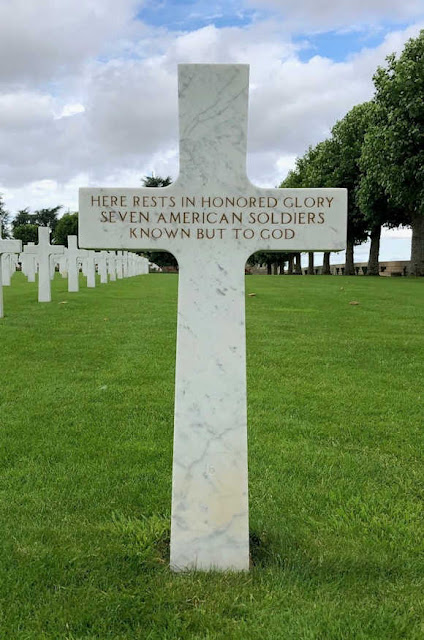The American Battle Monuments Commission’s (ABMC) Somme American Cemetery is located in the small French village of Bony, in the Hauts-de-France region. How well do you know this site? Here are five things you may not know about Somme American Cemetery.
 |
| Looking North, the cemetery sits where the 27th New York National Guard Division fought in September 1918 |
The first exhumation
In late December of 1920, Somme American Cemetery was the first cemetery to exhume the remains of service members for repatriation. After the two world wars, the families of fallen American service members had the option to either repatriate the remains of their loved ones or lay them to rest at U.S. military cemeteries abroad under the eternal care of ABMC. Approximately 40 percent of families during World War I opted for their service member to be buried overseas, alongside their brothers-in-arms.
Five sets of brothers
 |
| Photo of the Vedder brothers’ headstones at Somme American Cemetery, one of the five pairs of brothers buried at this site. |
For many years, it was believed that Somme American Cemetery had only four sets of brothers buried within its grounds, but in 2022, a fifth set of brothers was discovered when a cousin of Pvt. William Dunlap and Pvt. Felix Dunlap came to visit them at the site and explained the relationship between them to the ABMC team. Three of the five sets of brothers are buried side by side.
A single rosette
 |
| Bronze rosette near Pvt. Dalton Ranlet’s name on the Wall of the Missing to indicate his remains were recovered and identified. Pvt. Ranlet now has a headstone at the Cemetery. |
There is only one bronze rosette on the Wall of the Missing at Somme American Cemetery. It indicates Pvt. Ranlet Dalton was recovered and identified. When it happened in 1955, his family was given the same options that were offered during World War I—they could either repatriate his remains to the U.S. or have him buried at an ABMC site. They chose to inter his remains alongside his fellow service members, making Dalton’s burial unique, as he has both a headstone at Somme American Cemetery and his name on the Wall of the Missing.
A tie to Gold Star Mothers
 |
| Looking south, beyond the Memorial and Chapel is the battlefield where the 30th Tennessee/Carolina National Guard Division fought in September 1918 |
Many service members buried or memorialized at Somme American Cemetery were from Gilded Age families. Amongst them were 1Lt. George V. Seibold as well as MSgt. Harmon Vedder and Pfc. James Vedder. Their mothers, Grace Seibold and Effie Vedder, founded the Gold Star Mothers and pushed for the creation of the Gold Star Mothers’ Pilgrimage—a U.S. government program that paid the travel expenses to the grave sites for mothers and widows whose sons and husbands had died overseas. In addition, Effie Vedder also helped to rebuild the area around our site.
One headstone, seven sets of remains
Of the more than 1,800 burials at Somme American Cemetery, 138 are unknown. One of these headstones is particularly noteworthy, as it is the final resting place of not one but seven unknown service members. It also happens to be the last burial at Somme American Cemetery in 1972.
About the American Battle Monuments Commission
The ABMC’s mission is to honor the service of the Armed Forces by creating and maintaining memorial sites, offering commemorative services, and facilitating the education of their legacy to future generations. It was founded in 1923 following World War I and its 26 cemeteries and 32 monuments honor the service men and women who fought and perished during World War I (WWI), World War II (WWII), the Korean War, and the Vietnam War, as well as some who fought during the Mexican-American War.
Those sites are a constant reminder of Gen. John J. Pershing’s promise that “time will not dim the glory of their deeds.”
Appreciations to: Ashleigh Byrnes at ABMC; Somme American Cemetery team; Google Maps




Great article about a Magnificent Cemetery. Thank you for the information!
ReplyDeleteAnother aspect of the Somme Cemetery (other than it's actually in the Aisne rather than the Somme) is that it is seldom visited by Americans. The visitor log is dominated by British and Australian visitors. This, of course, is reflective of the fact that British Fourth Army and the Australian Corps were heavily engaged in the area, and American memory is dominated by First Army's efforts at the (relatively) distant Saint-Mihiel and Meuse-Argonne fronts. Also noteworthy is the chapel's frieze depicting a Renault FT tank. While British armored units sometimes had a single Renault in their inventory, heavy tanks would have been a far more common sight in the area, such as when the American 301st Tank Battalion attacked along with 27th Division in late September 1918.
ReplyDeleteIn a bit of irony, my Grandfather (a New Yorker) fought with the 107th Reg, 27th ID. My wife's great Uncle (a Carolinian) fought with the 30th ID. While I have decent documentation on my Grandfather, my wife's family has none-his name was William Jennings Bryant Elkins. I have often wondered if they had met 'over there'.
ReplyDelete